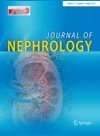Urinary renal tubular epithelial cells and casts as predictors of renal outcomes in patients with biopsy-proven diabetic nephropathy
Abstract
Background
Urine sediment examination is a time-tested and non-invasive diagnostic tool. This study investigated the characteristics of urine sediment and its association with severity and renal outcomes in diabetic nephropathy (DN) patients.
Methods
A total of 201 biopsy-proven diabetic nephropathy patients (according to the pathological classification of diabetic nephropathy proposed by the Renal Pathology Society in 2010) who underwent manual urine sediment microscopic examination were included. We compared the clinicopathological characteristics of diabetic nephropathy patients with and without urinary renal tubular epithelial cells (RTECs) or renal tubular epithelial cell casts. The predictive value of urinary renal tubular epithelial cells or renal tubular epithelial cell casts for renal outcomes in diabetic nephropathy was analyzed.
Results
Fifty of 201 (24.9%) diabetic nephropathy patients had renal tubular epithelial cells or renal tubular epithelial cell casts in urine sediment. Diabetic nephropathy patients with renal tubular epithelial cells or renal tubular epithelial cell casts in urine sediment had a significantly higher level of proteinuria [6.0 (3.1, 9.7) vs. 3.6 (1.8, 6.8) g/24 h, p = 0.001], higher serum creatinine [227.9 (151.6, 338.1) vs. 177.0 (104.4, 288.4) μmol/L, p = 0.016] and lower estimated glomerular filtration rate (eGFR) [25.8 (15.8, 44.8) vs. 35.7 (19.9, 65.0) mL/min/1.73 m2, p = 0.025] than those without. Cox regression analysis demonstrated that the presence of urinary renal tubular epithelial cells or renal tubular epithelial cell casts was independently associated with the development of end-stage kidney disease (ESKD) in diabetic nephropathy patients [HR 1.670, 95% CI (1.042, 2.676), p = 0.033]. Adding the presence of urinary renal tubular epithelial cells or renal tubular epithelial cell casts to the predictive model could improve the effectiveness of the model for predicting the risk of ESKD within one year after renal biopsy.
Conclusions
The presence of urinary renal tubular epithelial cells or renal tubular epithelial cell casts was associated with more severe kidney injury and worse renal outcomes in patients with diabetic nephropathy, thus perhaps providing a noninvasive biomarker for predicting diabetic nephropathy.
Graphical abstract




